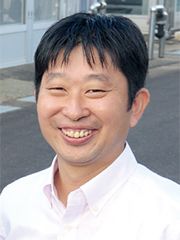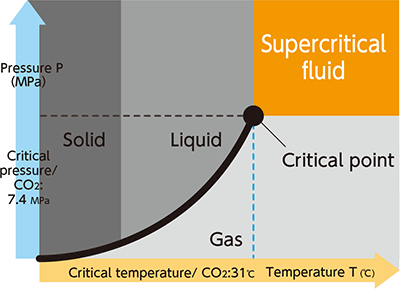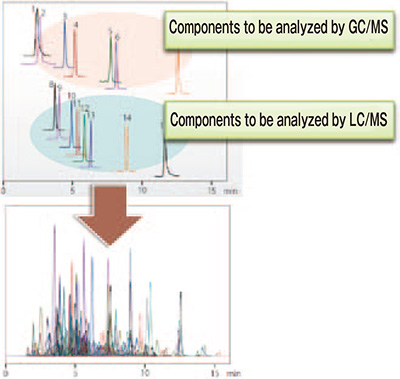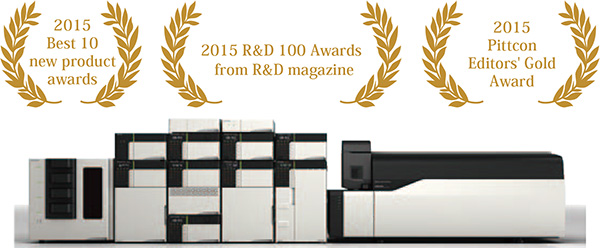Research Results
High-speed full-automatic component analysis using supercritical fluids
Application for pesticide residue analysis and disease diagnosis FY2016

- Takeshi Bamba (Professor, Medical Institute of Bioregulation, Kyushu University)
- Development of Advanced Measurement and Analysis Systems
- "Development of supercritical fluid extraction−separation instrument for mass analysis" team leader (2012-2014)
The importance of sample pre-treatment technique
Rapid and accurate data acquisition is demanded in practical application for safety evaluation of agricultural commodities and disease diagnosis. Sample pre-treatment to extract target components serves as major challenge but indispensible in chemical analysis. Extraction and separation of target components, are tedious, required skillful operator and can produce variation in terms of recovery rate and extraction accuracy. In addition, some components are subject to oxidation or decomposition thus may require specific extraction method. The development team led by Professor Takeshi Bamba has successfully resolved this challenging issue employing supercritical fluid based instrument that allows simultaneous extraction and separation analysis. It enables rapid, accurate, and fully automated system for multicomponent analysis.
Features of SFE-SFC system
The supercritical fluid refers to any substance at a temperature and pressure beyond its critical point. It has properties such as low viscosity and high diffusivity thus suitable to dissolve substances as well as effuse effectively through solid and narrow material. By controlling temperature and pressure, the properties of supercritical fluid can be modulated to dissolve more diverse substances. Supercritical Fluid Extraction (SFE) is a technique applying the principle of supercritical fluid, allowing extraction of components that are not dissolved in normal temperature and pressure. It has been used to extract caffeine from coffee beans. On the other hand, Supercritical Fluid Chromatography (SFC) is widely applied for isomers analysis in pharmaceutical field due to its high separation performance. Professor Takeshi Bamba is SFC expert and has engaged in the research field of SFC for more than fifteen years.
Because the two techniques are based on same dissolving media, his breakthrough idea is to connect the instruments that enable full-automatic SFE-SFC system for extraction and separation of multicomponents. Furthermore, development of instrument with tight sealed interconnecting system to prevent exposure of ambient air and light facilitates component analyses that have been difficult to accomplish up to now. However, co- existence of SFE extraction and SFC separation in a single scheme is still problematic since development of switchable multi-extraction vessels and advance system of flow path are challenging thus SFE-SFC system capable of continuous analysis of multiple components has not been applied for practical use.
Figure 1 Phase diagram of carbon dioxide

Development of simultaneous detection of 500 pesticide residues in a single analysis using SFE-SFC system
Professor Bamba had an opportunity to be acquainted with a key-person on the course of the SFE-SFC system development, Takashi Ando, the director of Miyazaki agricultural research institute. Takashi Ando is a leading expert in the research of supercritical fluid extraction of analysis of pesticides. He discovered the optimal condition of temperature and pressure for selective extraction of pesticide components. Professor Bamba and Takashi Ando established three-party project collaboration to develop SFE-SFC system with Shimadzu Corporation. The project was launched in 2012. Development of world's first full-automatic analysis system of SFE-SFC was successfully completed in an extraordinary speed within two years. With effective collaborative work and strong will among the participants, the project was finalized earlier than the initial plan to produce new innovative analytical system.
This analysis system eliminated any complicated pre-treatment and solve the latent problems in the sample extraction, such as reduction of variations in the component extraction due to manual operation, improvement of analysis speed and prevention of oxidation and decomposition. For analysis of residual pesticides in foods, the pre-treatment that used to take approximately thirty-five minutes in the traditional method was shortened to just five minutes and reduce the amount of organic solvent to approximately one-tenth. Additionally, the SFE/SFC system could successfully measure 500 pesticide components simultaneously that was conventionally achieved using multi-instruments. The applicability of SFE/SFC system was confirmed to seek blood biomarkers for early disease diagnosis at the experiments by Masaru Yoshida, the associate professor at Kobe University School of Medicine.
Simultaneous analysis of 500 components of pesticide

Simultaneous analysis of broad range pesticide components using SFE/SFC system
Highly acclaimed analytical system in domestic and overseas
Shimadzu Corporation commercialized and launched sales of the SFE/SFC analysis system in 2015. It was received Pittcon Editors'Gold Awards at Pittcon 2015 as the most innovative analysis product, 2015 R&D 100 Awards, which is regarded as the "Academy Award of Technology Innovation", and the 2015 Nikkan Kogyo Shimbun's Best 10 new product awards. In the future, the application of SFE/SFC system is expected to expand in a number of fields including the medical and nutritional fields for early stage diagnosis of diseases and research of functional component in food and many others. In near future, development of advanced measurement technology launched from Japan has a promising prospect to create new industry.
SFE-SFC-MS system commercialized by Shimadzu Corporation (Nexera UC).

